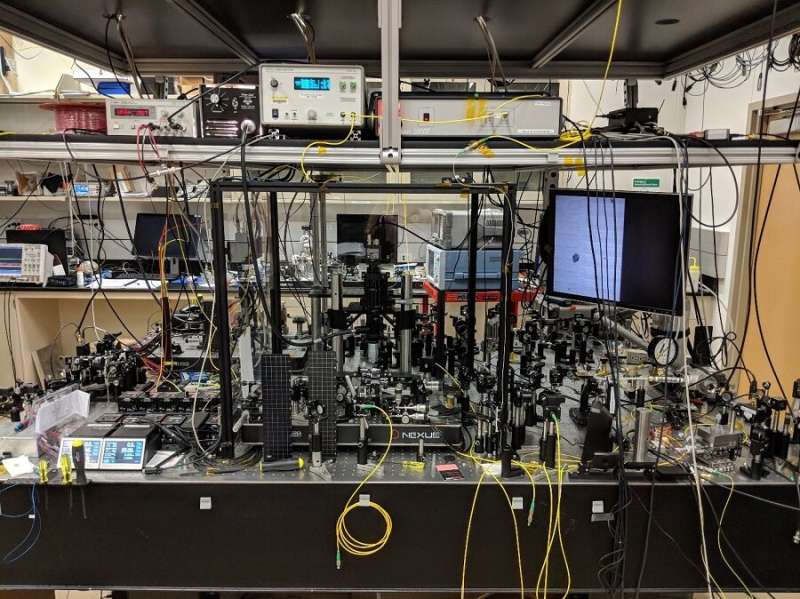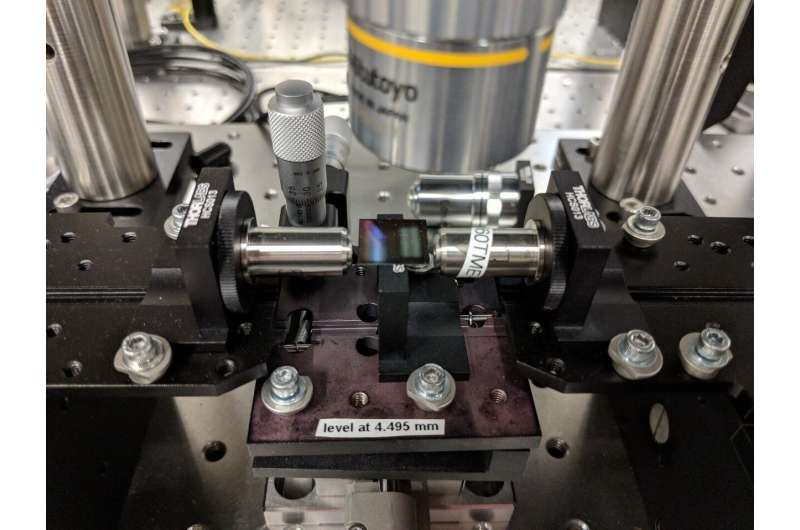Researchers demonstrate record speed with advanced spectroscopy technique

Researchers have developed an advanced spectrometer that can acquire data with exceptionally high speed. The new spectrometer could be useful for a variety of applications including remote sensing, real-time biological imaging and machine vision.
Spectrometers measure the color of light absorbed or emitted from a substance. However, using such systems for complex and detailed measurement typically requires long data acquisition times.
"Our new system can measure a spectrum in mere microseconds," said research team leader Scott B. Papp from the National Institute of Standards and Technology and the University of Colorado, Boulder. "This means it could be used for chemical studies in the dynamic environment of power plants or jet engines, for quality control of pharmaceuticals or semiconductors flying by on a production line, or for video imaging of biological samples."
In The Optical Society (OSA) journal Optics Express, lead author David R. Carlson and colleagues Daniel D. Hickstein and Papp report the first dual-comb spectrometer with a pulse repetition rate of 10 gigahertz. They demonstrate it by carrying out spectroscopy experiments on pressurized gases and semiconductor wafers.
"Frequency combs are already known to be useful for spectroscopy," said Carlson. "Our research is focused on building new, high-speed frequency combs that can make a spectrometer that operates hundreds of times faster than current technologies."
Getting data faster
Dual-comb spectroscopy uses two optical sources, known as optical frequency combs that emit a spectrum of colors—or frequencies—perfectly spaced like the teeth on a comb. Frequency combs are useful for spectroscopy because they provide access to a wide range of colors that can be used to distinguish various substances.
To create a dual-comb spectroscopy system with extremely fast acquisition and a wide range of colors, the researchers brought together techniques from several different disciplines, including nanofabrication, microwave electronics, spectroscopy and microscopy.

The frequency combs in the new system use an optical modulator driven by an electronic signal to carve a continuous laser beam into a sequence of very short pulses. These pulses of light pass through nanophotonic nonlinear waveguides on a microchip, which generates many colors of light simultaneously. This multi-color output, known as a supercontinuum, can then be used to make precise spectroscopy measurements of solids, liquids and gases.
The chip-based nanophotonic nonlinear waveguides were a key component in this new system. These channels confine light within structures that are a centimeter long but only nanometers wide. Their small size and low light losses combined with the properties of the material they are made from allow them to convert light from one wavelength to another very efficiently to create the supercontinuum.
"The frequency comb source itself is also unique compared to most other dual-comb systems because it is generated by carving a continuous laser beam into pulses with an electro-optic modulator," said Carlson. "This means the reliability and tunability of the laser can be exceptionally high across a wide range of operating conditions, an important feature when looking at future applications outside of a laboratory environment."
Analyzing gases and solids
To demonstrate the versatility of the new dual-comb spectrometer, the researchers used it to perform linear absorption spectroscopy on gases of different pressure. They also operated it in a slightly different configuration to perform the advanced analytical technique known as nonlinear Raman spectroscopy on semiconductor materials. Nonlinear Raman spectroscopy, which uses pulses of light to characterize the vibrations of molecules in a sample, has not previously been performed using an electro-optic frequency comb.
The high data acquisition speeds that are possible with electro-optic combs operating at gigahertz pulse rates are ideal for making spectroscopy measurements of fast and non-repeatable events.
"It may be possible to analyze and capture the chemical signatures during an explosion or combustion event," said Carlson. "Similarly, in biological imaging the ability to create images in real time of living tissues without requiring chemical labeling would be immensely valuable to biological researchers."
The researchers are now working to improve the system's performance to make it practical for applications like real-time biological imaging and to simplify and shrink the experimental setup so that it could be operated outside of the lab.
More information: David R. Carlson et al, Broadband, electro-optic, dual-comb spectrometer for linear and nonlinear measurements, Optics Express (2020). DOI: 10.1364/OE.400433
Journal information: Optics Express
Provided by The Optical Society





















